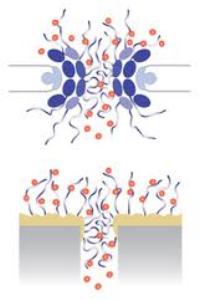The method of controlling the transport of proteins in and out of the nucleus makes the nuclear pore complex (NPC) biologically important. They act like a lock system filtering the active molecules, thereby enabling precise exchange of specific proteins in a highly selective way.
 natural and artificial nuclear pore complexes
natural and artificial nuclear pore complexes
Each NPC-lock measuring only 50 nm in diameter opens when it recognizes a substance as a molecular guest and closes when it does not recognize a substance as a guest.
The actual function of the NPC-lock system remains a mystery to the researchers as no technical device is available to imitate this system. In 2006, a researcher called Lim recommended an idea to mix NPC proteins with engineered nanostructures and nanopores. After five years, Lim’s team, together with another research team headed by Prof. Cees Dekker, Delft University of Technology, found that an NPC replica is capable of matching the power and quality of a real NPC found in a cell. They found that the molecular selectivity accuracy and the time of transport of molecules in milliseconds of both the duplicate model and the natural NPC are equal. These results are published in Nature Nanotechnology and help to understand and identify the fundamental principles of NPC function at individual molecular level.
The researchers continue to apply the basic principles of NPC function to selectively transport specific proteins with high precision from their natural biological location to the desired target. Synthetic polymers replaced the blocks of biological NPC-lock. The replacement of natural components with artificial ones is vital as it offers complex transport systems with technologically molecular components to match with one another in a living cell.